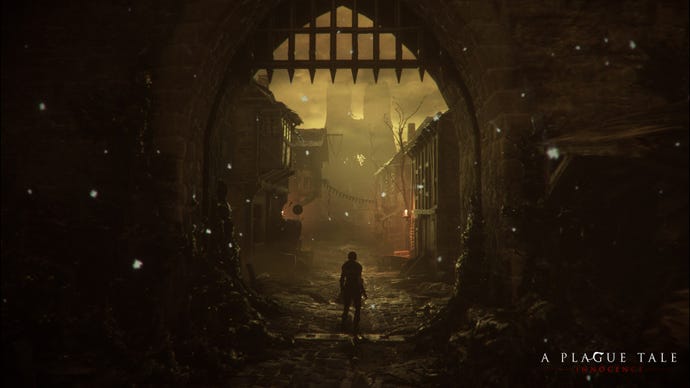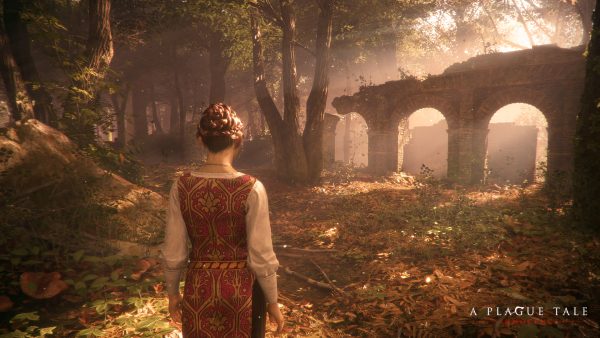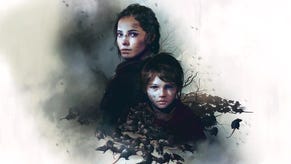A Plague Tale: Innocence hands-on - a complex tale of death, love and war
I’m a big fan of French medieval literature and history, especially when it involves the Black Death. A Plague Tale: Innocence takes place during the Hundred Years’ War, where rats, plague and the Inquisition were a regular occurrence, depicting the horrors inflicted upon France and how it destroyed families and lives.
The game begins in an idyllic French forest, filled with crisp, orange leaves, as we meet our heroine, Amicia de Rune on a walk with her father. After slingshotting some apples from a tree - this will be your weapon of choice for the majority of the story - your faithful pooch, Leon, spots a boar. A chase ensues, doubling up as a tutorial for the game’s stealth elements, and you’re lured into the idea that this will be a nice wee game with lots of dogs.
As you run after Leon, however, the once beautiful forest begins to turn dark, a sour note plays in place of the light music and you find the boar dead. A black, tar-like pit has ensnared Leon and he is lost to the darkness.
Quite the juxtaposition, eh?
You sprint back to the castle where we meet Amicia’s mother and younger brother, Hugo, who has a serious ailment of some kind. It’s here where we meet the Inquisition, in particular, Lord Nicholas, who demand you hand over Hugo. Using a mixture of stealth and distraction, you manage to flee the home with Hugo, though Amicia’s parent's fates are less lucky.
The short prologue sets the pace for what's to come, as you avoid the Inquisition and crazed villagers searching for the doctor, Laurentius. Here, you’re introduced to A Plague Tale’s robust yet simple crafting system, which allows you to craft a better sling, increase the size of your ammo bag and other equipment.
There are several puzzles in each area, which are highlighted by a glowing object. You can throw rocks at certain items to get a guard's attention or at metal hooks which hold up crates which you can then push and climb over to reach higher ground.
I spoke with one of Asobo Studios co-founders, David Dedeine, who said that, as the story progresses, there will be a few ways you can approach a puzzle or an area in order to move on to the next section, giving you a different experience each time. We also talked about difficulty levels, with the puzzles in A Plague Tale remaining fairly straightforward, once you notice them, so as not detract from the story and make the game overly repetitive.
In many ways, A Plague Tale reminded me of Horizon Zero Dawn, as you move silently through the long grass, using rocks to distract or attack enemies. The combat system is also somewhat similar, in that you need to use your sling to knock off pieces of armour from enemies in carefully timed attacks.
There were no quick-time attacks during the boss fight I encountered, however, I had to lure the enemy into swinging his weapon a few times before it became stuck in the ground, presenting me with a fleeting opportunity to knock a bit of his armour off.
Much like the rest of the opening chapters, there isn’t much time to catch your breath. The ambient music ebbs and flows as you’re presented with the next stressful event, with Amicia’s agitated breathing becoming louder during stealth sections. A Plague Tale is best played with headphones for maximum effect to experience the thrilling milieu.
While there were only a handful of rats scurrying across the landscape in the opening chapters of A Plague Tale, they will play a much larger role as the game progresses. You’ll be able to lure a disgusting horde of rats towards enemies, acting together as a hive-mind as they chew down on anything in their path. As you progress, you’ll go from hearing the odd squeak from a stray rat to a deafening squeal as swarms converge on enemies and burst out through the ground below. It’s as skin crawling as it sounds.
The bond between brother and sister is set to blossom as Hugo and Amicia learn to appreciate one another and you learn more about Hugo’s affliction. It’s implied that Hugo may be the cause of the plague, despite appearing healthy, as his illness was so profound yet misunderstood.
The idle threat of English soldiers, combined with the plague and the formidable Inquisition means that Amicia and Hugo are constantly facing new, ever-present threats. Dedeine spoke with me about the deliberate choice to cast Amicia as the older sister, the responsible and boyish firstborn who is wary of her brother, a boy completely shut off from the world, the war and the Inquisition. Their relationship is non-existent at the beginning of the game and she follows her mother's instructions to find the doctor out of a sense of duty, not love.
Despite an adequate understanding that they must hide from the bad guys and find the doctor, Amicia and Hugo’s naivety and childishness gets in the way. It reminded me of Ellie from The Last of Us, where she belligerently ignores Joel's instructions out of a warped sense of self-importance and plain immaturity. The annoying child trope is exactly that and was again a deliberate choice, but it certainly adds to the trepidation in the opening chapters of A Plague Tale.
After killing someone for the first time, the tone of A Plague Tale shifts profoundly as the first wall of innocence is shattered for Amicia. It was an incredibly emotional hands-on experience and it reminded me a lot of the first chapter of The Walking Dead where Lee and Clem experience the horror of the undead full-on from the word go.
While there’s no word of a Nintendo Switch port yet, A Plague Tale: Innocence releases on May 14 for Xbox One, PC and PS4.










